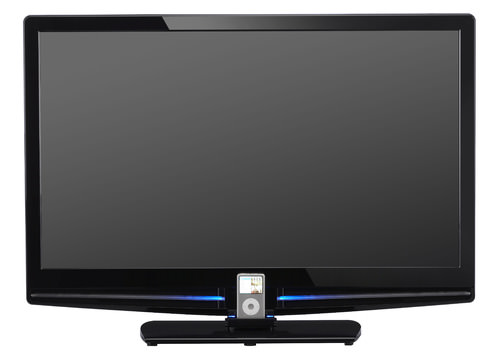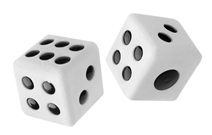实验概率
Section outline
-
Jordan did a survey for his media class where he timed the length of TV advertisements (in seconds). The data he collected is shown below in the table.
::约旦对其媒体班进行了调查,他将电视广告的长度(以秒计)计时,收集的数据如下表所示。Length (s)
Frequency 0 – 19 17 20 – 39 38 40 – 59 19 60+ 4 He needs to find the probability ratio that:
::他需要找到的概率比率是:-
An advertisement will be between 20 and 39 seconds.
::广告将在20至39秒之间发布。 -
An advertisement will be less than 40 seconds.
::广告时间不到40秒
In this concept, you will learn to define and calculate experimental probability .
::在此概念中,您将学会定义和计算实验概率。Experimental Probability
::实验概率Experimental probability is probability based on doing actual experiments -flipping coins, spinning spinners, picking ping pong balls out of a jar, and so on. To compute the experimental probability of a number cube landing on 3, you would need to conduct an experiment . Suppose you were to toss the number cube 60 times.
::实验概率是基于实际实验的概率 — — 抛硬币、旋转旋键、从罐子中挑选乒乓球等等。 要计算数立方体在3上着陆的实验概率, 您需要进行实验。 假设您要扔60倍的立方体 。
::有利结果=3
::结果共计=60 索谢Experimental probability:
::实验概率 :
::P(活动)+++++++++++++++++++++++++++++++++++++++++++++++++++++++++++++++++++++++++++++++++++++++++++++++++++++++++++++++++++++++++++++++++++++++++++++++++++++++++++++++++++++++++++++++++++++++++++++++++++++++++++++++++++++++++++++++++++++++++++++++++++++++++++++++++++++++++++++++++++++++++++++++++++++++++++++++++++++++++++++++++++++++++++++++++++++++++++++++++++++++++++++++++++++++++++++++++++++++++++++++++++++++++++++++++++++++++++++++++++++++++++++++++++++++++++++++++++++++++++++++++++Let’s look at an example.
::让我们举个例子。What is the experimental probability of having the number cube land on 3 when the cube is rolled 60 times?
::当立方体滚动60倍时, 将数字立方体降落在 3 的实验概率是多少 ?Trial 1 2 3 4 5 6 Total Raw data: 3’s 1 3 0 1 2 2 9 Total Tosses 60 The data from the experiment shows that 3 turned up on the number cube 9 out of 60 times.
::实验数据显示60次中有3次出现在数字立方体9上。
::实验概率=有利结果:总结果
::实验概率=9:60Simplified, this ratio becomes:
::简化后,这一比率变为:
::实验概率=3:20You can see that it is only possible to calculate the experimental probability when you are actually doing experiments and counting results.
::您可以看到,只有在实际进行实验和计算结果时,才有可能计算实验概率。Examples
::实例Example 1
::例1Earlier, you were given a problem about Jordan and the timed advertisements.
::更早之前,你被问及约旦和定时广告的问题。Jordan collected his data in a graph and needs to find the probability ratio that:
::约旦在图表中收集了他的数据,需要找到概率比率,即:-
An advertisement will be between 20 and 39 seconds.
::广告将在20至39秒之间发布。 -
An advertisement will be less than 40 seconds.
::广告时间不到40秒
Length (s) Frequency 0 – 19 17 20 – 39 38 40 – 59 19 60+ 4 Total 78 First, look at the data from the experiment to see how many times an advertisement was between 20 and 39 seconds. These are the favorable outcomes.
::首先,看看实验的数据,看看广告在20秒到39秒之间有多少次。这些都是有利的结果。
::有利结果=38
::结果共计=78Next, calculate the experimental probability.
::接下来,计算实验概率。
::实验概率=有利结果:总结果
::实验概率=38:78Then, simplify the ratio.
::那么,简化比例。
::实验概率=38:78
::实验概率=19:39The answer is 19:39.
::答案是19点39分The experimental probability that an advertisement will be between 20 and 39 seconds is 19:39.
::广告在20至39秒之间的实验概率是19:39。First, look at the data from the experiment to see how many times an advertisement was less than 40 seconds. These are the favorable outcomes.
::首先,看看实验的数据,看看广告有多少次不到40秒。这些都是有利的结果。
::有利结果=17+38=55
::结果共计=78Next, calculate the experimental probability.
::接下来,计算实验概率。
::实验概率=有利结果:总结果
::实验概率=55:78The answer is 55:78.
::答案是55: 78The experimental probability that an advertisement will be less than 40 seconds is 55:78.
::广告不到40秒的实验概率是55:78。Example 2
::例2Use the table to compute the experimental probability of a number cube landing on 6.
::使用表格计算数立方体在6上着陆的实验概率。Trial 1 2 3 4 5 Total Raw data: 6’s Favorable outcomes: 6’s 4 1 1 2 1 9 Total Tosses 50 First, look at the data from the experiment to see how many times a six turned up when rolling a number cube and also what was the total number of outcomes.
::首先,看看实验中的数据 看看在滚动一个数字立方体时, 6次出现多少倍, 以及结果的总数是多少。
::有利结果=9
::结果共计=50Next, calculate the experimental probability.
::接下来,计算实验概率。
::实验概率=有利结果:总结果
::实验概率=9:50The answer is 9:50.
::答案是9点50分The experimental probability is 9:50.
::实验概率是9: 50A number cube was tossed twenty times. The number 2 came up 3 times and the number 5 came up six times. Use this information to answer the following questions.
::一个数字立方体被丢弃了20次。 数字2 翻了3次, 数字5 翻了6次。 使用此信息回答下列问题 。Example 3
::例3What is the probability that the number would be a 2?
::数字是2的概率是多少?First, look at the data from the experiment to see how many times a 2 turned up when rolling a number cube and also what was the total number of outcomes.
::首先,看看实验中的数据, 看看在滚动一个数字立方体时每2个出现多少次, 以及结果的总数是多少。
::有利结果=3
::结果共计=20Next, calculate the experimental probability.
::接下来,计算实验概率。
::实验概率=有利结果:总结果
::实验概率=3:20The answer is 3:20.
::答案是3点20分The experimental probability is 3:20.
::实验概率是3: 20Example 4
::例4What is the probability that the number would be a 5?
::数字是5的概率是多少?First, look at the data from the experiment to see how many times a 5 turned up when rolling a number cube and also what was the total number of outcomes.
::首先,看看实验中的数据 看看在滚动一个数字立方体时, 5次出现多少倍, 以及结果的总数是多少。
::有利结果=6
::结果共计=20Next, calculate the experimental probability.
::接下来,计算实验概率。
::实验概率=有利结果:总结果
::实验概率=6:20Then, simplify the ratio.
::那么,简化比例。
::实验概率=6:20
::实验概率=3:10The answer is 3:10.
::答案是3点10分The experimental probability is 3:10.
::实验概率是3: 10Example 5
::例5What is the probability of not rolling a 5?
::不滚动5的概率是多少?First, look at the data from the experiment to see how many times a 5 did not turn up when rolling a number cube and also what was the total number of outcomes. You know that it 5 did turn up 6 times in the 20 tosses.
::首先,看看实验中的数据,看看在滚动一个数字立方体时,每5个数据有多少次没有出现, 以及结果总数是多少。你知道,每20个倾斜点中,5个数据确实出现6次。
::有利结果=20-6=14
::结果共计=20Next, calculate the experimental probability.
::接下来,计算实验概率。
::实验概率=有利结果:总结果
::实验概率=14:20Then, simplify the ratio.
::那么,简化比例。
::实验概率=14:20
::实验概率=7:10The answer is 7:10.
::答案是7点10分The experimental probability is 7:10.
::实验概率是7: 10Review
::回顾Find the probability for rolling less than 4 on the number cube.
::在数字立方体上找到滚动小于 4 的概率 。1. List each favorable outcome.
::1. 列出每项有利结果。2. Count the number of favorable outcomes.
::2. 计算有利结果的数目。3. Count the number of total outcomes.
::3. 计算总结果的数目。4. Write the probability.
::4. 记录概率。Find the probability for rolling 1 or 6 on the number cube.
::在数字立方体上找到滚动 1 或 6 的概率 。5. List each favorable outcome.
::5. 列出每一有利结果。6. Count the number of total outcomes.
::6. 计算总结果的数目。7. Write the total number of outcomes.
::7. 记录结果总数。8. Write the probability.
::8. 记录概率。A box contains 12 slips of paper numbered 1 to 12. Find the probability for randomly choosing a slip with a number less than 4 on it.
::框中包含12张编号为1至12的纸片,找到随机选择一个号码小于4的滑纸的概率。9. List each favorable outcome.
::9. 列出每一有利结果。10. Count the number of favorable outcomes.
::10. 计算有利结果的数目。11. Count the number of total outcomes.
::11. 计算总结果的数目。12. Write the probability.
::12. 记录概率。Use the table to answer the questions. Express all ratios in simplest form.
::使用表格回答问题。以最简单的形式表示所有比率。Use the table to compute the experimental probability of flipping a coin and having it land on heads.
::使用该表来计算翻硬币的实验概率, 并让硬币在头顶上降落 。Trial 1 2 3 4 5 6 Total Raw data(heads) Number of heads 5 6 6 3 6 5 31 Total number of flips 10 10 10 10 10 10 60 13. How many favorable outcomes were there in the experiment?
::13. 实验中有多少有利结果?14. How many total outcomes were there in the experiment?
::14. 试验中有多少总结果?15. What was the experimental probability of the coin landing on heads?
::15. 硬币在头顶上着陆的实验概率是多少?Review (Answers)
::回顾(答复)Click to see the answer key or go to the Table of Contents and click on the Answer Key under the 'Other Versions' option.
::单击可查看答题键, 或转到目录中, 单击“ 其他版本” 选项下的答题键 。 -
An advertisement will be between 20 and 39 seconds.

